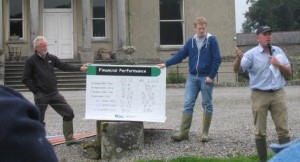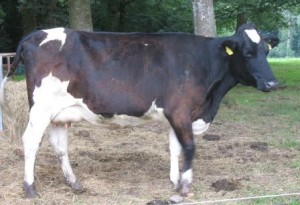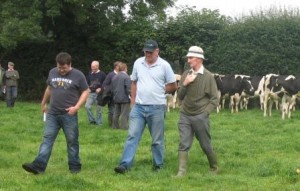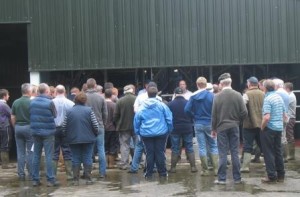Last week I had the opportunity to attend a Monitor Farm Walk in County Wicklow. A Monitor Farm is a farm agrees to work closely with Teagasc and their milk coop, in this case Glanbia coop. A Teagasc Advisor works with the farmer to measure grass and cow productivity, soil testing, milk testing, and financials. The farmer agrees to make changes that will show the use of best practices, and to open the farm up for articles, newsletters and ‘walks.’ On 8/28, about 60 farmers visited Fortgranite Farm.
Pier Dennis owns the real estate of the farm, and is in an operating partnership with John Roche. They are milking 125 cows now, with the plan of getting up to 170 cows in 2015 (when the EU dairy marketing quota ends). Dairy farm partnerships are a pretty new idea here in Ireland.
Dairying in Ireland is much different than in Vermont. Dairy marketing quota has been the limiting factor, putting a limit on the amount of milk that could be sold. So making milk as cheaply as possible has been the way to increase profits. This farm is planning on expanding by keeping all dairy heifer calves. They plan on shipping more fat and protein per cow from their breeding program (they are paid for this, not for volume, since most milk is turned into dairy products for export).
The second stop for the day was grass growth. The farmers had a budget for the supply and demand of grass by week though the end of October. The plan includes how many cows would be on the grass, and amount they would be eating. As grass growth slows down in the fall, they have will be removing late lactation cows from the pastures and putting them into a free-stall barn and begin feeding them grass silage. The budget included how much grass they wanted left in the fields at the end of the season, because the grass continues to grow very very slowly during the winter, and the grass needs leaf surface area in the early spring to start growing again. The ground is not covered by snow for a couple of months here. The Gulf Stream usually hits Ireland head-on, making for a mild winter.
Next stop, Soil Fertility. There was a soil test comparison report from 2008 and 2013. This report was set up so that you could see the % of fields testing high medium and low for pH, P, and K. It was very easy to notice that the pH of the soils had moved from nearly half below a pH of 6, to over 90% having a pH of over 6. Advisors said that this change in acidity ‘released a bag of urea per hectare per year.’ The news for P and K was just as obvious, but not as good. They had moved from no soil tests being deficient in P to over half being deficient. And K had moved in the same direction, but not so bad.
In general in Ireland, the P levels in the soil have dropped. People are speculating that this is due to the Nitrate Directive from the European Union 7 years ago that limited the amount of N that could be applied. Farmers began applying less manure and purchased fertilizer per acre. As this happened, the amount of P that the soils were receiving from manure went down. And to make matters worse, farmers were reading the target rates of P application as limits, so were buying fertilizer with a lower level of P. Advisors said that moving a soil P test from level 1 (low) to 3 (a high average) would ‘feed a cow for the winter, provide another 1.5 T more grass per hectare.’ (There is a shorter winter feeding season here than in Vermont!)
Bulk Milk Disease Screening. A veterinarian with the Glanbia dairy cooperative spoke about tests that the coop conducts on milk samples from each member farm. They test for BVD, IBR, Lepto, Salmonella, plus stomach worms, liver fluke, and the Schmallenberg virus (that is relatively new in the country). The vet described what the readings on the tests meant, how the readings varied by season, the impact of the diseases, and what additional treatments or vaccinations this herd could be doing for these diseases. One question about Johnnes disease brought the response that they cannot test bulk milk samples for Johnnes, it is too dilute in samples from the bulk tank. There is a voluntary Johnnes program now in effect.
The last stop was milk quality and the new milking parlor. The advisor pointed out the strengths and weaknesses of the new parlor. He made the suggestion that the best thing to do with hi cell count cows is to cull them, ‘give them to God.’ Or if you needed the milk, you could dry off the quarter. He gave high praise to the California Mastitis Test, the paddle with 4 test pits. Make sure that people were using gloves while milking to avoid spreading bacteria from cow to cow. And advised people to be aware of how hard their water was if they were mixing teat sprays, and when washing dairy equipment.
These Monitor Farms exist around the country, with many different coops involved. They are a means to get information out to farmers via ‘show and tell.’ Farmers have plenty of opportunity to talk while walking from one stop to another. And there is plenty of time for questions, comments and discussion. This is the home page for one group of Monitor Farms, http://www.teagasc.ie/areaunits/teagasc_glanbia/index.asp





